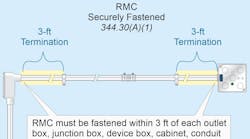Q. What are the working space and access requirements in the Code for equipment located above suspended ceilings or in a crawl space?
Scroll Down to See the Answer
A. These requirements are new to the 2017 NEC.
Where equipment operating at 1,000V or less is likely to require examination, adjustment, servicing, or maintenance while energized is located in a space with limited access, all of the following conditions apply [110.26(A)(4)]:
(a) Equipment installed above a suspended ceiling must have an access opening not smaller than 22 in. × 22 in. Equipment installed in a crawl space must have an accessible opening not smaller than 22 in. × 30 in.
(b) The width of the working space must be a minimum of 30 in., but in no case less than the width of the equipment.
(c) The working space must permit equipment doors to open 90°.
(d) The working space in front of the equipment must comply with the depth requirements of Table 110.26(A)(1), the height is what is necessary to install the equipment. Horizontal ceiling structural members are permitted in this space.





